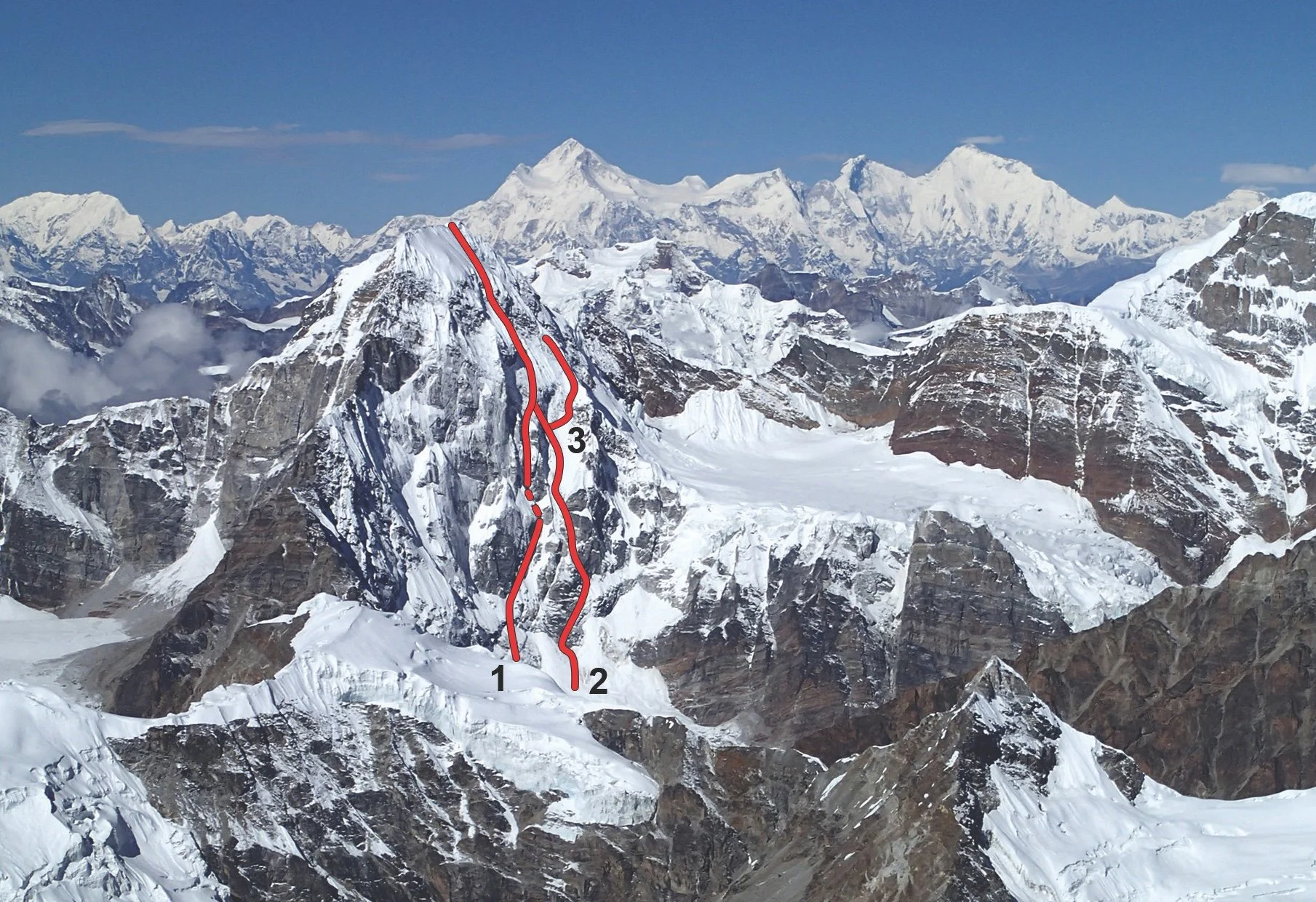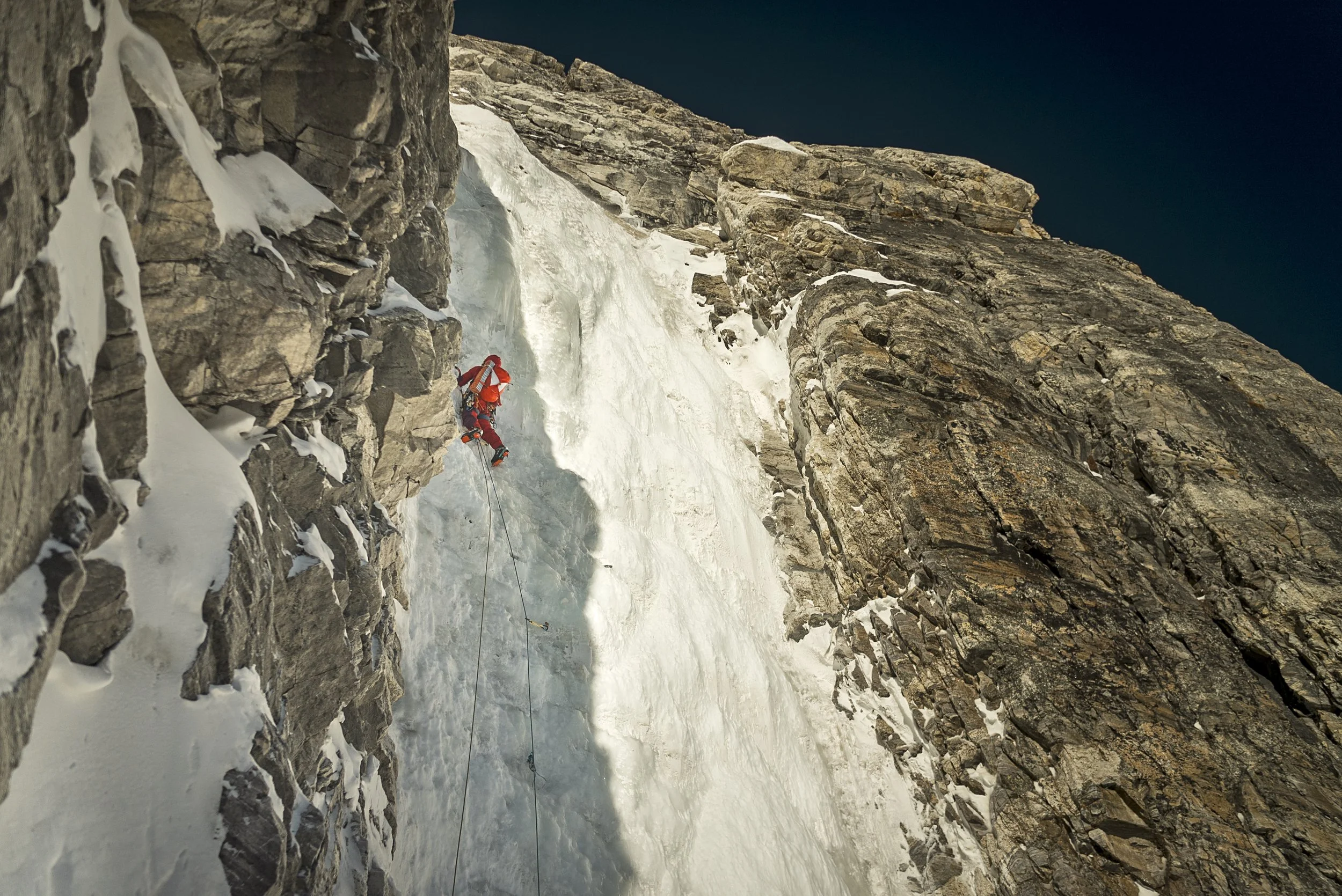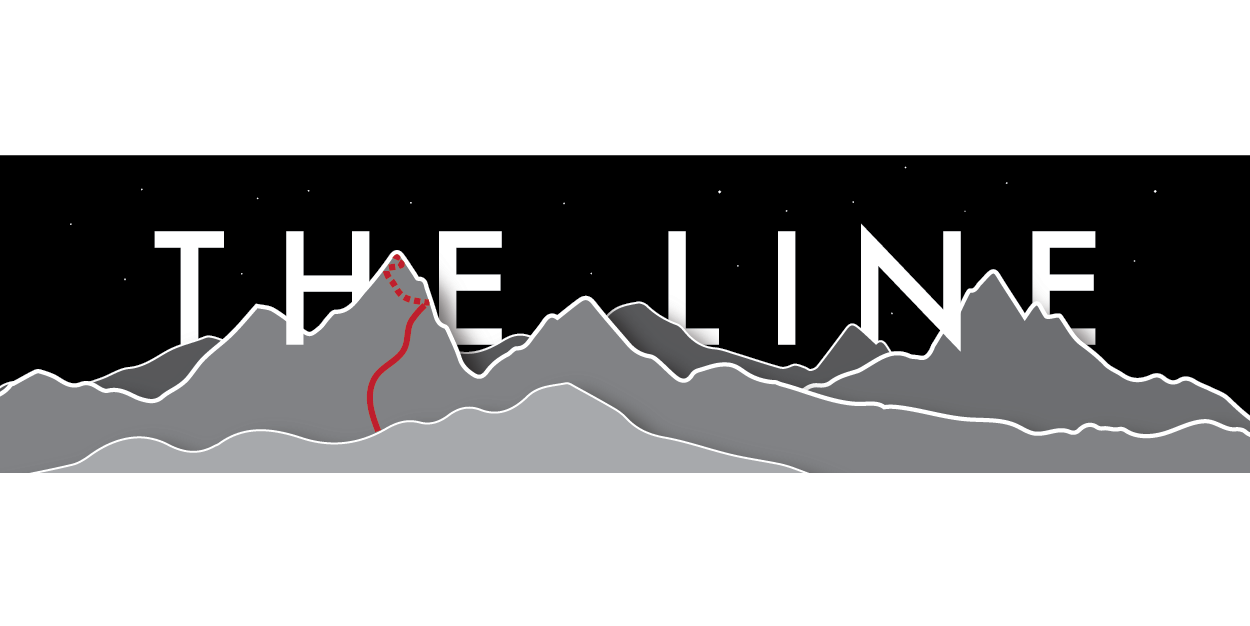In 2009, Kei Taniguchi from Japan became the first woman to win a Piolet d’Or (along with climbing partner Kazyua Hiraide) for a new route up 7,756-meter Kamet in India. Tragically, neither Taniguchi nor Hiraide are still with us. In AAJ 2025, we’re publishing a story by Akihiro Oishi, Taniguchi’s biographer, who set out to complete a route she had attempted years earlier in Nepal. We’re sharing part of Oishi’s story here.
The photo that started it all: the northeast face of Pandra in October 2013. At that time, the face was unclimbed. Subsequently, the marked lines were climbed or attempted: (1) Peine Plancher (2017, the first ascent of the face), (2) A Piece of the Sun (2024), joining the 2017 route to the summit, and (3) the Taniguchi-Wada attempt (2016). The peak at far left, in the distance, is Chamlang; the Tibetan side of the Makalu-Lhotse-Everest group is in the center. Photo: Hiroshi Hagiwara
PANDRA, A PIECE OF THE SUN
“Mr. Hagiwara, what mountain is this?”
The question was asked by Kei Taniguchi as she looked at a picture taken by Hiroshi Hagiwara, editor of Rock and Snow, in 2013. The photo showed the unclimbed northeast face of Pandra (6,673 meters) in eastern Nepal.
In 2016, Taniguchi attempted Pandra with Junji Wada, retreating from two-thirds height (AAJ 2017). On return to Japan she wrote, “I’ve opened Pandora’s Box. I will definitely go back to check what’s inside.” Tragically, a month later, she fell to her death from Mt. Kurodake in Japan.
I interviewed many people to compile a book about Kei’s life, called A Piece of the Sun. In the final chapter, I hoped to incorporate a scene in which some of us, including Wada, climbed Pandra. However, Wada was seriously injured just before our team was due to leave Japan, and the expedition was postponed. Finally, in 2024, eight years after Kei’s accident, I went to Pandra with Suguru Takayanagi and Hiroki Suzuki to complete Kei’s route. Wada had become a family man, starting a new life.
We arrived at our 5,100-meter base camp on October 12. The approach to advanced base and the face itself had changed significantly in eight years due to global warming: The northeast face looked far drier than in pictures taken by the French team that completed the first route up the face. [In October 2017, one year after the attempt by Taniguchi and Wada, French climbers Mathieu Détrie, Pierre Labbre, and Benjamin Védrines completed Peine Plancher (1,200m, WI6 M6; see AAJ 2018).]
After acclimatization, we left advanced base for Pandra at 7 a.m. on October 25. It took three hours to reach the foot of the wall, after which we climbed to a bivouac site at 5,500 meters, where we pitched the tent using a snow hammock. The climbing to this point, following the line taken by Taniguchi and Wada, had involved crumbling rock and brittle ice.
Early on the second day of the ascent of the northeast face of Pandra, climbing the Pandra Great Icicle. Photo: Suguru Takayanagi
On day two, we climbed three pitches of excellent, steep alpine ice, dubbed the Pandra Great Icicle. Above, a couloir with poor protection and belays cut through the center of the face, and at 5,800 meters we made our second bivouac.
On the 27th, we headed directly toward the summit. [From around this point or below, in 2016, Taniguchi and Wada traversed to the north spur; the 2024 team continued direct and joined the line of the 2017 French route, which came in from the left.] At around 6,000 meters, the French party had found a pitch of M6. Takayanagi, who is about ten years younger than us, onsighted that pitch easily—he should achieve great things in the Himalaya. At 6,200 meters, we found a bivouac site beneath a rock outcrop.
Akihiro Oishi, belayed by Hiroki Suzuki, traverses insecure snow on the fourth day of the ascent of Pandra’s northeast face. Photo: Suguru Takayanagi
The next morning, we left our bivouac gear and headed for the top. Takayanagi climbed an overhang that was much more difficult than the M6 the day before. We then climbed ice and difficult sugar snow, with little meaningful protection, to reach a snow cave at around 6,500 meters after dark. We shivered through the night in just the clothes we were wearing.
With Suzuki in the lead, it took only 30 minutes to reach the top the next morning. Suzuki shouted, “Whoa, we did it!” I’ve been climbing with him for 20 years, but this was the first time I’d heard a serious roar. By 4 p.m. we had returned to our snow cave, and the following day we rappelled to the base.
We named our route A Piece of the Sun. It will continue to burn in our hearts and guide us toward greater mountains.
—Akihiro Oishi, Japan, with help from Kaoru Wada, Hiroshi Hagiwara, and Rodolphe Popier
Kei’s Climbs in the AAJ
Kazuya Hiraide (left) and Kei Taniguchi in 2008, leaving base camp for acclimatization before their first ascent of the southeast face of Kamet in India. Photo: Taniguchi Collection
2004 Taniguchi and Kazuya Hiraide complete a new route up 7,027-meter Spantik in Pakistan; partner Kazuo Tobita, who was ill, remained at high camp.
2005 After warming up and acclimatizing with the second ascent of the southeast ridge of 7,546-meter Muztagh Ata in China, Taniguchi and Hiraide complete a partial new route on the north side of Shivling in India.
2008 Taniguchi and Hiraide make the first ascent of the southeast face of Kamet, the climb that earned them the Piolet d’Or. Their alpine-style ascent was completed in a 12-day round trip from base camp.
2011 The same pair climb a new route on 7,694-meter Gurla Mandhata in Tibet and traverse the mountain, bagging the first ascent of the south peak along the way.
Kei Taniguchi and Junji Wada celebrating after 38 days on the Ruth Glacier in Alaska. Photo: Taniguchi Collection
2014 Taniguchi serves as the leader for a small group of female college students from Japan who make the first ascent of Mansail in Mustang, Nepal. The same year, she and Junji Wada climb a number of routes, some of them new, above the Ruth Amphitheater in Alaska.
2016 Taniguchi and Wada attempt Pandra in Nepal, retreating from the north spur after four days of climbing in November.
Less than a month after returning home from Nepal in 2016, Kei Taniguchi died in a fall while descending Mt. Kurodake on Hokkaido. She was 43. Kazuya Hiraide, her main partner for the great climbs of the early 2000s, died on the west face of K2, along with Kenro Nakajima, in July 2024.
Akihiro Oishi, Taniguchi’s biographer and the author of our Pandra report, wrote a feature article about her for Alpinist 68. You can read the first half of the story online.
Request for Reports
Have you or your friends climbed a long new route this year in Alaska, Peru, Bolivia, Kyrgyzstan, or Greenland? We’re working right now on these sections for the 2026 AAJ. Email us about significant first ascents in these locations…or anywhere in the world!
The Line is Powered by:
The Line is Supported by:
The Line is the newsletter of the American Alpine Journal (AAJ), powered by Arc’teryx, with additional support from Mountain Project by onX. The line is emailed to more than 80,000 climbers each month. Sign up below to received future emails. Find the archive of past editions here. Got a potential story for the AAJ? Email the editors at [email protected].








